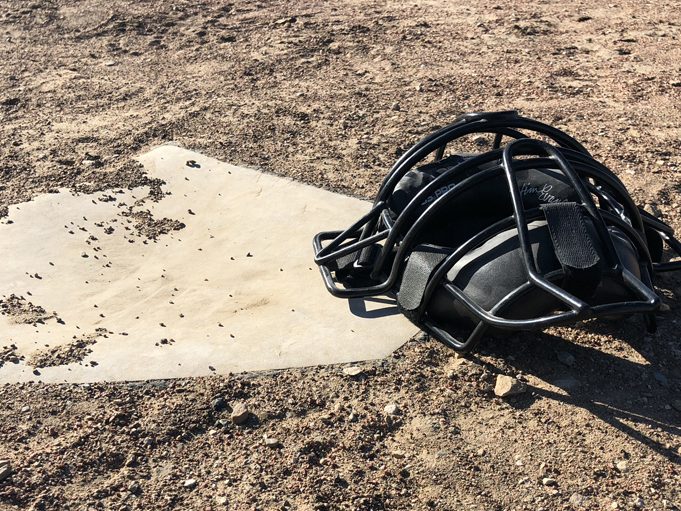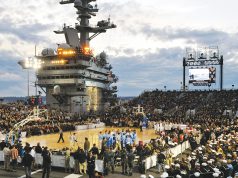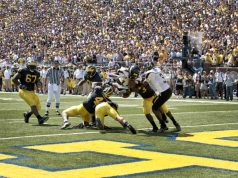Ron Luciano, who died in 1995, was one of the classic arbiters and characters of the 1970s in professional sports. An AL umpire for 11 years, he was one of the most visible and controversial men to ever work between the foul lines. Many of the things he did in his career would make an official cringe today, but they might help us appreciate how far we’ve come.
Luciano grew up in an apartment over his parents’ restaurant in Endicott, N.Y. He was a mediocre baseball player, so he turned to football because of his size and agility, winning a scholarship to Syracuse University. While working on a math degree, he garnered All-America honors as an offensive tackle, blocking for the great Jim Brown. After four years on the injury list in pro football, he retired and tried teaching but gave that up when he realized schools had lots of children.
With zero officiating experience, he went to Al Somers’ umpire school in 1964 and, remarkably, graduated and made it to the majors in just five seasons. Once in the bigs, he shredded the code of conduct for umpires but endeared himself to fans with his talkativeness, histrionics and charm.
Boy, has officiating changed in a generation.
One thing they might question today would be Luciano’s professionalism: He bought hot dogs during the game, flew paper airplanes and had a trademark of calling runners out-out-out by pretending to rapid-fire a gun; his record was 16 shots. On “very bad days, which followed soon after very good nights,” he was known to ask catchers he trusted to help him with balls and strikes by framing the pitches that were strikes. For balance, a fellow umpire once said, “Ronnie doesn’t so much show up for a game as he arrives. He walks through both dugouts saying hello to people, talking to the fans, getting everyone in a good mood for when the game starts.”
Tom Topping umpires NCAA softball and is also the sport’s coordinator in the Iowa Intercollegiate Athletic Conference. He says officiating today is mostly about professionalism. “I think (professionalism) has gone up several notches,” says Topping. “You have to treat it more like a business now than as an avocation or a hobby, especially in softball.
“You have to be more consistent with other umpires and more prepared for games, especially from a fitness aspect where that wasn’t stressed as much before.”
Topping includes taking responsibility for one’s actions on and off the field as a big-ticket item. That’s because officials are more likely than they once were to be recognized in public because of media coverage: You can gain as much bad press for yourself and fellow officials in the corner bar as you can at third base, something Luciano didn’t seem to see as a big concern.
In comparison to hockey or basketball referees, some might not think of umpires as needing a high level of fitness. The speed of the athletes and the arduous schedules they now work change that. In fact, Luciano retired before the 1980 season when he realized, at 290 pounds, he just couldn’t get in position like he once could to get the right angle on a play — in a four-umpire system. He thought he would be cheating players if he stuck around.
It was ironic in a way because one of the things his supervisors liked was his “good size,” which translated into a license to command the proceedings. Other former umpires like Eric Gregg and John McSherry were legendary for their girth. Gregg was fined by baseball because of his weight and the issues it created in his work. McSherry, after several scares, died in 1996, on opening day in Cincinnati, because of complications of his poor fitness. Where size was once an asset in game control, today it’s a liability. Just ask John Adams.
Adams, NCAA national coordinator of men’s basketball officiating, has been assigning officials to the NCAA basketball tournament since 2008 and many would regard him as a groundbreaker in setting the specifications for the modern official.
“When I got the job in 2008,” explains Adams, “we evaluated every call by every official in the 2008 tournament. Consistently, there was a theme on missed calls of officials being out of position or not being in good position to see the play.
“One of the things we’ve worked on in our community is raising the level of officials’ fitness and our call accuracy percentage has gone up from 80 percent to as much as 90 percent in just five years.”
Adams says that some popular refereeing names don’t appear in the tournament because his evaluation is they can’t keep up with the pace of play. He has made it plain that fitness and mobility are his top two factors in deciding who will be selected to the tournament among those with suitable experience.
In Adams’ mind, the need for the stress on accuracy stems from the increased scrutiny of officials that the modern media has brought to bear. There was a time when a network basketball game might be covered by two or three cameras, supplemented by stop-action replay. Under those conditions, even if a broadcaster chose to replay a controversial call out of respect for the officials, the video evidence would often be inconclusive — remember Franco Harris’ Immaculate Reception (or not?) Now that game coverage is more sophisticated and evidence of incorrect calls can circle the globe in seconds, people like Adams have gone all-in to find the best people to produce uncommon accuracy. And it starts with fitness.
A trademark of many officials in Luciano’s time was their ability to put a stamp on the game; to take charge and deal with issues before things could get ugly. Supposedly, former Dodger Manager Tommy Lasorda was once a minor league pitcher. In winter league ball one season, he started chattering at the Cuban plate umpire over his concept of the strike zone. When the umpire had heard enough, he walked out to Lasorda, smiled and opened his coat to display perhaps the largest handgun Lasorda had ever seen. Their differences were immediately resolved: Effective, but not a career builder.
Management is far more important than bluster in running a game today. Luciano believed that any umpire who showed hesitation or any vulnerability was destined for a short career. They substituted iron-fisted debating skills for the lack of video evidence of their skills back then. Someone had to take charge and a lot of the officials of that era were well known for their aggressiveness. Name more than a few such personalities today. Marcia Alterman bets you can’t.
Alterman was a top-notch NCAA volleyball official before becoming the executive director of the Professional Association of Volleyball Officials (PAVO). In her tenure she’s seen the dynamic between first and second referee change considerably. When she started, it was like a master-slave relationship. The up official exerted a level of authority and decision-making extending to the shores of the seven seas; the down official hoped one day to be so revered.
“The culture on that getting-it-right thing really has changed,” Alterman says. “We’ve kind of mimicked other sports and gone away from ‘the first referee is always correct’ culture that we had for years.
“At the college level we’ve emphasized the get-it-right philosophy to the point where we’ve encouraged the second referee to step up when they have information to add to a play.”
In addition to creating fewer controversies in an average match, it’s created the opportunity for specialization. Volleyball officials frequently come as matched sets now, with a great play-caller up top and a great administrator and soother in front of the table, between the benches. That helps because she agrees with the others that coaches have become more fractious and difficult to deal with.
Luciano wrote that he only ever asked for help on one call in 10 years. He was blinded by the setting sun one evening on a pole-bender home run, guessed wrong and had an entire dugout disgorge on him. It was such an obvious and excusable error that the umpires’ normal phobia of appearing indecisive didn’t apply. Compare that to today.
“It’s not unusual to get together on a play maybe once a weekend,” says Mike Conlin, an NCAA baseball umpire who also supervises basketball officials for the Horizon League. “I don’t want to say it’s become the norm, but it is common.
“I think it’s happened because it’s a completely different mentality with baseball. … I think, over time, it’s become recognizable that there are pieces where it’s in everybody’s best interest to get things right.”
It isn’t that the quest for perfection has changed over the past couple of decades; it’s that people have learned to tunnel under the stone wall officials used to build around their fallibility. What’s crept in is that officials now accept that they’ll make mistakes because the games are so much more athletic. So, they’re now more willing to fess up and straighten things out, as long as it doesn’t become a habit.
OK, maybe it is a sign of strength, but if these group discussions bring more focus on the officials, “Let the teams decide it,” is bound to echo from the rafters. Conlin says, “The players do decide the game. The officials in any sport work the game the way the rules committees want them officiated.”
We could probably name many people just in our own neighborhoods who would regard that as a truism. Yeah, more fouls create more whistles, but aren’t officials supposed to compensate by calling fewer fouls, or only calling them when the situation dictates? Conlin doesn’t think so.
“Twenty years ago, you could look at contact in a play and be comfortable not blowing your whistle,” Conlin said. “Now the coaches are concerned about the amount of contact in the game and it not being won and lost in the dressing room and things like that. So now, they’re asking us to call things closer.”
Conlin and Adams agree that it restores the balance of play, which had swung toward the defense under a softer approach. Adams believes the best officials call the same foul, the same way whether in the first or last minute of a game; there is no room for stepping in early and setting a standard for what they’re willing to call, then letting the players run amok for a while and then buttoning things down with the game on the line. From Adams’ viewpoint, the need for that consistency is another consequence of the increased physicality of sports today.
Adams says finding enough people who are unwavering in how they call a game is a challenge. While it might be a question of foul-calling consistency in basketball, it manifests itself differently in other sports.
Luciano made the point that the umpires of his era were defined by their strike zones. He described his as an oval. He had trouble bending down far enough to be sure on the low corners and he thought having the top of the strike zone at the armpits was only fair if the ball was out over the plate. In his time, it fell to the players to get used to each umpire’s tendencies. Today, that would be heresy. In softball, Topping says, the NCAA uses and distributes video of its umpires’ games to make sure the strike zone is the standard rectangle, no matter who has the plate. It’s important because batters are equally well-coached to know the strike zone and lay off the right pitches.
Doesn’t “calibrating” officials so much take some of the humanity out of it? Maybe, but the consensus is we should all get used to it.
Another place where uniformity has become a raison d’être is in the realm of safety, the big fish in any sport’s pond these days. Luciano despised the beanball, especially after he saw the career of Baltimore’s Paul Blair changed by a “purpose pitch” that fractured his skull. Billy Martin once declared to him while exchanging lineup cards before a doubleheader that his Rangers would pitch at the Brewers’ Robin Yount every time he came to bat — and then they did. Luciano threw Martin out of both games and then was almost fired for criticizing the light treatment he thought Martin got from the league. The way Luciano looked at it, if a pitcher could throw at a batter, why couldn’t the batter go out to settle things with the pitcher? He said there were even times he’d give the batter a head start when he charged the mound: Try to imagine reading that on the front page of the sports section today.
Safety in sports is no longer something to be settled at the whim of the participants. Neither can its requirements be sampled like a smorgasbord by the officials. Gary Whelchel knows that as well as anyone.
Whelchel is the commissioner of officials for the Arizona Interscholastic Association (AIA) and regards managing safety as paramount. He says it often involves administrating issues that have nothing to do with when the ball’s in play. In 1905, Teddy Roosevelt threatened to ban football unless colleges found a solution to the deaths caused by head injuries. It wouldn’t be entirely surprising if another president soon repeats that threat.
The AIA was one of the early experimenters with the football rule benching players whose helmet comes off during a play. The data Arizona produced was a big driver in the NFHS beefing up the rule in recent years, says Whelchel. The state has also adopted a concussion education program called the Barrow Brainbook: No player or official may participate in a contest unless they’ve passed the course with an 80 percent or better score. Safety protocols are taking no prisoners.
Being a safety-conscious official is as much about mediation and avoiding litigation as it is about determining forward progress. For Whelchel, that creates the secondary issue of finding the right observers to identify the right officials to work his state tournaments. The AIA has a policy that no official works state in consecutive years, so there’s a premium on having a good scouting program. Those observers, he explains, are often the retired, old-school people who are products of yesteryear’s successes. You have to do a lot to school them to select officials on the basis of the current requirements, which includes managing safety issues.
Whelchel says something else is the greatest threat to retaining officials. “The issue where we’re losing officials isn’t with their concerns over dealing with player safety,” he said. “Of more concern is the violence of the fans and those sorts of things that are occurring in society. They’re concerned whether somebody’s going to come up behind them or attack them out of the stands.”
Every jurisdiction, from the smallest middle school to the biggest college, has a policy of zero tolerance for intimidating referees. Nonetheless, the threat grows and the worst incidents have sometimes resulted in the deaths of officials. Whelchel says that the potential for abuse, plus an improving economy where potential officials have a better chance to find other work, has made it harder to find new officials. What did you experience the last time you were trying to replace a crewmate?
“In the past few years managers have started getting physical with umpires. A manager, or player, should never, ever, under any circumstances, touch an umpire. Throughout baseball history managers have been forbidden to touch the umpire and umpires have had a limited amount of trouble from fans. But if that barrier breaks down, and it seems to be cracked right now, umpires will start having real problems with the fans.” That wasn’t Whelchel speaking. Luciano wrote that in The Umpire Strikes Back, in 1982. Some things never change.
Do the level of preparation, scrutiny and the efforts at uniformity risk making officiating become sterile? Will there be any room for personality or flexibility? For that matter, is it even ethical to prepare for the tendencies of two teams anymore, lest we be biased?
Yes, absolutely yes. Luciano said he took up baseball “to avoid the blind dates arranged by his mother” but learned to love the game once he understood its nuances. Knowing the strengths, weaknesses and tendencies of the players in front of him and how it all played out made every game something new to look forward to. As the players left the field after one such game late in Luciano’s career, he wrote, “I wanted to tell them all, thanks for letting me be part of it.” Despite all the different things we’re being asked to do, it’s still about the game and we still get to enjoy it when the lights come up.
After retirement, Luciano worked briefly for NBC as a baseball color analyst. He then wrote five books about the human condition, thinly disguised as humorous reminiscences of his time in baseball. He summed it up this way: “When I started, (baseball) was played by nine tough competitors on grass, in graceful ball parks.
“But while I was trying to answer the daily Quiz-O-Gram on the exploding scoreboard, a revolution was taking place around me. By the time I was finished, there were 10 men on each side, the game was played indoors, on plastic, and I had to spend half my time watching out for a man dressed in a chicken suit who kept trying to kiss me.”
The San Diego Chicken and artificial turf didn’t change umpiring. They merely illustrate why officiating is changing. Sport is a cultural activity and a form of entertainment. How we play games changes at the will of the participants — the fans, teams and administrators. As officials, we’re there to help deliver what they want. If we have the same passion for the game, then changing our ways to accommodate is the way to go; if we can’t handle the change, we’re welcome to move on. Whatever the case, we are still part of the solution and our leaders want us to be the best we can be.
Situation normal.
What's Your Call? Leave a Comment:
Note: This article is archival in nature. Rules, interpretations, mechanics, philosophies and other information may or may not be correct for the current year.
This article is the copyright of ©Referee Enterprises, Inc., and may not be republished in whole or in part online, in print or in any capacity without expressed written permission from Referee. The article is made available for educational use by individuals.



















